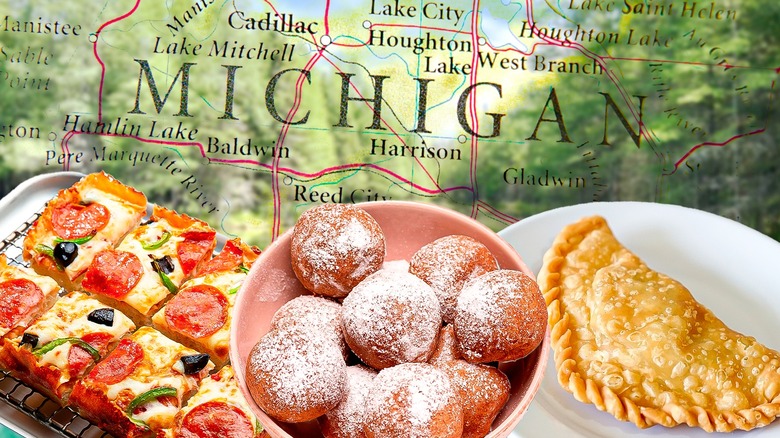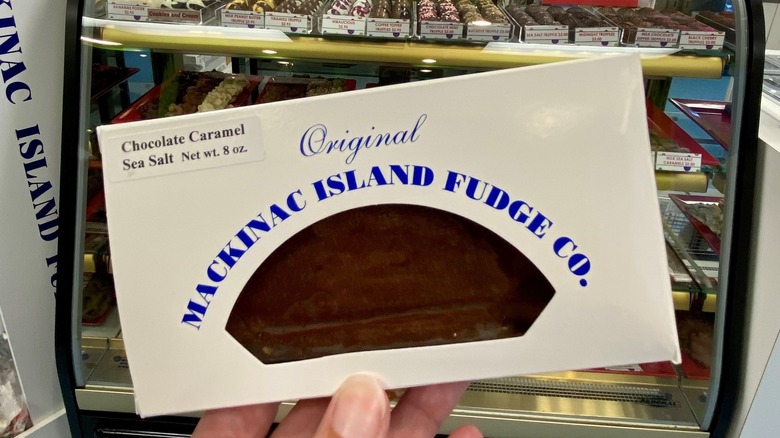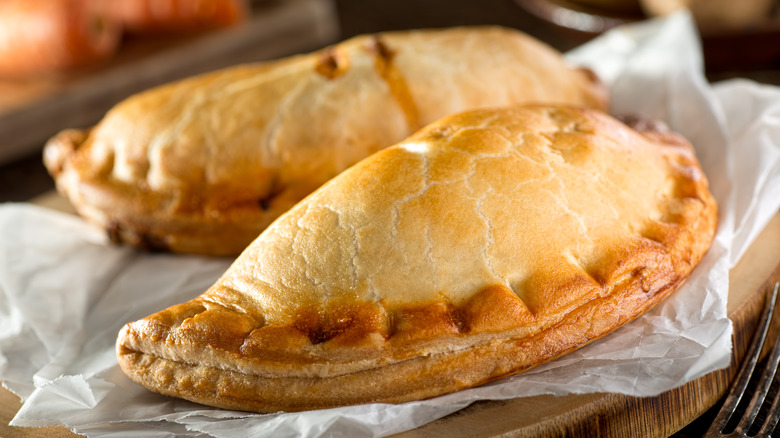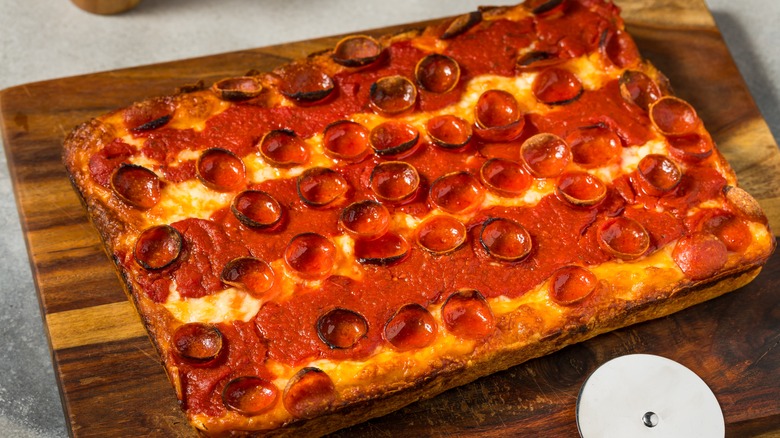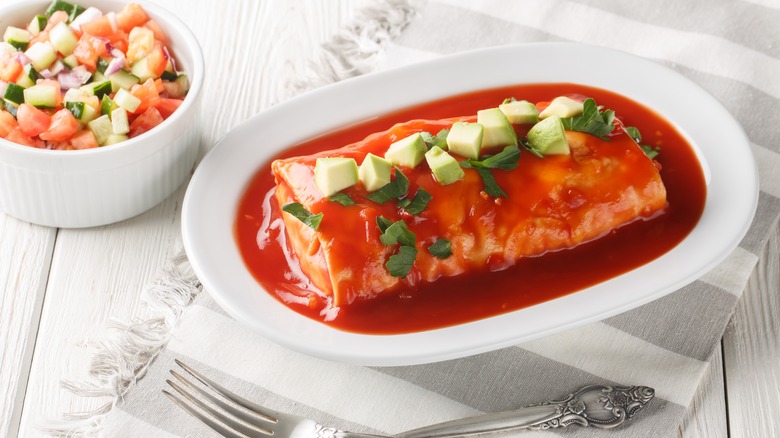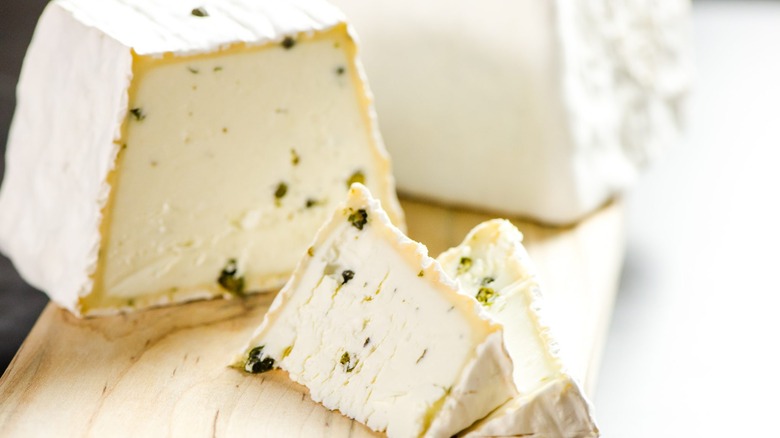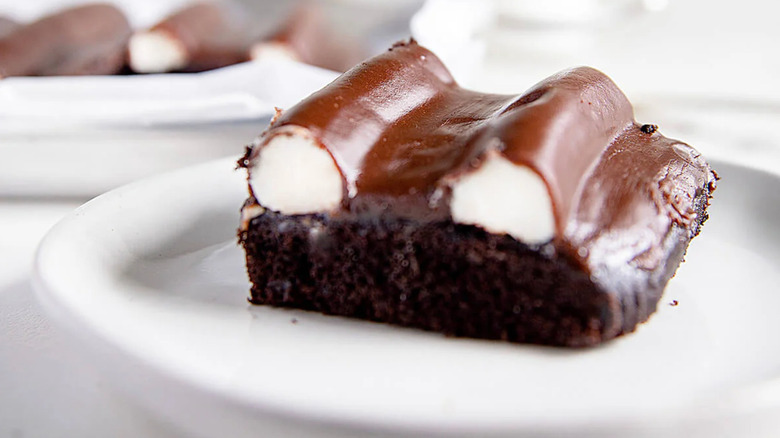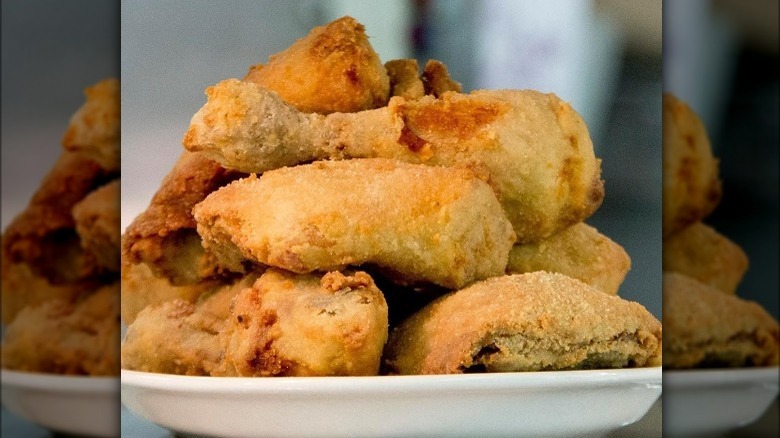12 Iconic Michigan Foods You Should Try At Least Once
Michigan is defined by its quaint lake towns, jaw-dropping scenery, and virtually limitless collection of tasty cuisine. The state is a melting pot of flavors and culinary excellence, drawing influence from around the world while showing off different cooking styles in each of its major cities and locales. No matter where you go within the state's borders — from Detroit to Lansing to Frankenmuth — you're bound to find a confluence of sweet treats, savory meals, and salty snacks.
Now, as a lifelong Ohioan, I've often fallen into the habit of referring to Michigan as "that state up north." But the Mitten State (if you will) is actually bursting with some pretty remarkable food products. While many of these tastes and recipes have trickled over the border into Ohio eateries, I've also taken my fair share of trips up to the state and immersed myself in all the wonders of these dishes and delights.
Given my extensive firsthand experience and endeavors within the state, I can say the following fare is some of the absolute best Michigan has to offer. Here are the most scrumptious and iconic Michigan foods you won't want to miss during your next visit.
Mackinac Island fudge
There's nothing quite like summertime on Mackinac Island. During that time of year, you'll find this charming (and car-less) stretch of land teeming with flowers, bike riders, sailboats, and tourists taking in the expansive views of Lake Huron. Of course, we couldn't possibly forget about the troves upon troves of fudge found on the island, as well.
Mackinac Island has a rich history in fudge making. Churning out thousands of pounds of the dense confection every single day during the peak season, it's even been designated the unofficial Fudge Capital of the World. With a total of 13 fudge shops on Mackinac Island as of 2023 — an impressive amount considering it has an area of less than 4 square miles — sampling some from each location has become something of a sport as visitors parade down the islet's idyllic Main Street.
From sea salt caramel and butter pecan to Oreo and peanut butter, flavors are manifold — though chocolate inevitably stands as the most popular. Additionally, if you're averse to hopping on a ferry boat or plane to reach the secluded island (or simply don't have the time), don't worry. Many of these famed shops will ship treats anywhere in the U.S. so you don't have to miss out on the fudgy fun.
Boston coolers
Before you ask, no: I did not slip up here and mistake Michigan for Massachusetts. The Boston cooler is, in fact, a specialty of the Great Lakes state. In a nutshell, it's a drink made up of vanilla ice cream and ginger ale — but not just any ginger ale. Specifically, this iconic Michigan beverage uses the spicy soda from Detroit-born brand Vernor's, which was invented all the way back in the 1860s.
Now, this may sound similar to another soft drink and ice cream combo dubbed a float. However, it's a smidge different, as vanilla scoops are blended into the soda in the form of a milkshake rather than being left to bob (or float) in the bubbly beverage. As for the title itself, many say this sweet treat was named after Boston Boulevard in Detroit, which is close to the original Vernor's soda fountain.
Additionally, history shows the term was actually invented prior to Vernor's getting its hands on the recipe. Prior to that, Boston cooler was used in ice cream parlors and soda shops as a catch-all name for any mixture of pop and ice cream. Despite the delicacy's hazy past, Vernor's did trademark the designation in 1967 – meaning there's no question now regarding who's the true king of Boston coolers.
Cornish pasties
Not to be confused with a pastry (with an "R") – and alternatively pronounced with a soft "a" sound – a pasty is another Michigan icon that should be on your radar. This culinary creation has been filling the stomachs of Michiganders for over 150 years, specifically in the Upper Peninsula. Cornish immigrants were actually the ones who brought the recipe Stateside. Evidently, being handheld made for a convenient and filling meal inside the mines where many settlers made their living.
A pasty lands somewhere between a calzone and a savory turnover. For all intents and purposes, it's another form of meat pie, but one that's dressed in an extra thick crust so it can be picked up and eaten on the go. Ground beef or pork are often the included meats of choice, accompanied by hearty veggies like potatoes, onion, carrots, and rutabagas (a cross between cabbage and a turnip).
However, pasties are known for their versatility and can be stuffed with essentially any protein or fillings of your choice. To finish it off with a supplemental blast of flavor, the crusty pockets are generally served with a side of one of America's favorite condiments: ketchup. Then again, gravy is another option if that's more your speed.
Detroit-style pizza
It seems that every corner of the U.S. has its own take on pizza. In Chicago, you'll find sky-high deep-dish slices stuffed with almost too much cheese (keyword: almost). New Yorkers prefer thin crust, while California pizzerias top pies with non-traditional garnishes like chicken, avocado, or even artichokes. There is one American-made pizza style, however, that Sicilians specifically would approve of — and it hails from none other than Detroit, Michigan.
Detroit-style pizza first appeared in 1946 at the restaurant Buddy's Pizza. It was here that owner August "Gus" Guerra experimented by making a thick, fluffy, and almost focaccia-like dough (somewhat akin to Sicilian-style pizza from the southern Italian island). Guerra then sprinkled this dough with Wisconsin brick cheese, thus creating the crispy, chewy, and cheesy crust that defines this type of pizza.
Of course, it can also be identified by its rectangular shape and square (rather than triangular) slices. As for toppings, standard pepperoni is a longstanding favorite, but as is the case with any pie, the chef — or the customer — has the power to take some creative liberties. No matter how you top it, there's no denying it's a Michigan must-try.
Coney dogs
Similar to Boston coolers, there's some debate regarding the genesis of the Coney dog (perhaps we should change the name of this article to mysterious Michigan foods). Many people would assume the famous frank got its start on Coney Island in Brooklyn, New York — where Nathan's Famous Hot Dog Stand first set up camp in 1916. However, Detroit once again lays claim to an American classic. Both Greek and Macedonian immigrants brought the recipe to the area starting in the 1900s, and the Detroit Coney dog overtook the city like a sloppy yet satisfying wave.
You may be wondering what, exactly, constitutes a Detroit Coney dog? Well, it starts out like any old hot dog: with a beef frankfurter burrowed inside a steamed bun. But its garnishes of a meat-filled (and bean-less) chili, diced white onions, and drizzling of yellow mustard set it apart. It sounds like a doozy, but it contains just the right amount of savory flavors. There's an endless number of eateries within the metro Detroit area that serve this specific hot dog breed, including icons like American Coney Island, Duly's Place, and Lafayette Coney Island.
As an Ohioan, I can attest that every Detroit Coney dog I've consumed within Michigan's mitten-shaped boundaries has far exceeded those found elsewhere. They're even better than the hot dogs served at my home state's cherished gem Skyline Chili (apologies in advance to my Cincinnati friends out there).
Wet burrito
Before I get ahead of myself, let me say that the standard everyday burrito does indubitably come from Mexico. No one could (or should) possibly take that meaty accomplishment away from our southern neighbor. But when it comes to the dish known as a wet burrito — which is found on menus all across the country — the credit has to go to Michigan.
The first ever wet burrito was introduced by the Beltline Bar in Grand Rapids, Michigan in 1966, and the restaurant still wears this achievement as a burrito-sized badge of honor. It touts this fact on its website and menus, and you can find close to a dozen wet burrito options on its bill of fare as of August 2024. The standard — known as Beltline's "The Famous" — is stuffed with all the usual suspects like ground beef, beans, lettuce, and tomatoes, then drowned in a burrito sauce and plenty of shredded Colby cheese on top. It might be the one and only burrito type that I would classify as fork-and-knife style fare rather than a handheld.
Trust me: This famous smothered meal really does taste best when you're sitting at a Michigan eatery. Of course, if you can't swing a trip to the Midwest state, it's also a fairly simple recipe to make at home. Just remember to toast your flour tortilla before adding any sauce to prevent sogginess!
Detroit Street Brick cheese
To avoid any confusion, I'll start by saying that Detroit Street Brick cheese actually hales from Ann Arbor, Michigan, and has no direct ties to the Motor City. The fromage is actually named after the cobblestone road where Zingerman's Creamery resides (yes: I'm just as baffled by the naming of Michigan's streets as you).
From the outside, this iconic Michigan food looks like goat cheese that's flecked with green peppercorns and shaped much like a brick (go figure). However, it's so much more than that. Within its rind, it's also hiding a lemony zest that plays exceptionally well with the natural tanginess of the goat cheese and gives each bite a light and crisp feel. The entire block is also dense yet spreadable and its peppercorns add the perfect amount of crunch to balance out the creaminess.
Zingerman's admits this bold and one-of-a-kind cheese is its most popular among restaurant and catering customers. Plus, Detroit Street Brick cheese was an American Cheese Society winner in 2006, 2007, and again in 2012. In other words, you know it'll be incredibly smelly and cheesy, but in the best possible ways.
Superman ice cream
The Mitten State is no stranger to frozen dairy treats. Sweet tastes swirl around its many lake towns and metros, including local ice cream brands like Hudsonville. But there's one Michigan-originated flavor that soars above the rest. That's right: we're talking about Superman ice cream. It's an unparalleled creation that leaves a lasting impression in vibrant hues of red, blue, and yellow — not to mention lingering dye stains on your tongue.
This iconic Michigan food is named after the dashing superhero because the colors match the shades of his suit. However, the flavor was actually concocted during Prohibition before Superman — and his alter ego Clark Kent — was even dreamed up by DC Comics. The origin of its name, then, is really just one of the mysteries surrounding this colorful Michigan ice cream.
Another mystery surrounds the flavor itself. Some say the red portion is synonymous with raspberry, strawberry, cherry, or even cotton candy. The yellow is known to be either vanilla, banana, or lemon, while he blue takes after Blue Moon ice cream (which is an enigma in and of itself). Frankly, all of the above could be correct since the recipe often changes per supplier. What I know for sure is that each and every batch of Superman ice cream is bound to be fruity, fun, and the first to catch a kid's eye at the ice cream shop.
Paczki
Calling all donut lovers. Michigan has a sweet delicacy holed up within its walls that you're going to want to hear about. Similar to the story of Cornish immigrants flocking to the northern parts of the state with their specialized fare, Polish people also found their way to the region — and brought with them multiple beloved recipes, includes paczki.
These traditional treats are made of spherical deep-fried dough balls generally piped with a sweet filling, like fruity jelly or custard, and topped with either powdered sugar or icing. Based on core build alone, they sound like your average, everyday American donut. However, they're known to be denser — and even more flavorful — than the sugary rings you typically find here in the U.S.
Paczki can be enjoyed at any time and for any occasion (not that you need any excuse). The absolute best time to indulge in this Polish pastry, though, has to be on Paczki Day. The special holiday always coincides with Fat Tuesday, which lands in either February or March, and is the day before Ash Wednesday (or prior to the start of Lent). This is one of the most exciting Michigan days of the year to celebrate, splurge, and find paczki galore in and around the state's big cities.
Olive burger
In terms of controversial foods, olives are about as polarizing as they come. Some people think the tree fruit is the absolute pits, while others can't get enough of the briny, oily ovals. It would appear that Michigan as a whole is on the favoring side, given it's the state that gave life to the unique olive burger. The Kewpee Hotel in Flint is rumored to have first crafted the sandwich: a clever yet simple combination of chopped green olives, Swiss cheese, and mayonnaise piled onto a standard beef patty.
This handheld food is by no means gourmet. Rather, it's salty, meaty, and unique enough to captivate the upper Midwest region. Despite its reported origins in Flint, the area where you'll find the most olive burger zeal actually lies southwest in Lansing, Michigan. Now considered "The Olive Burger Capital of the World" by some, the state's capital city is speckled with countless olive burger-serving spots and was the site of the first-ever Olive Burger Festival in 2023.
Featuring innumerable iterations of the iconic burger, the event was a success, and is slated for another go-around in October 2024. Sounds like it's time to extend an olive branch to your anti-olive friends and invite them to join in on the merriment — they may just come around.
Bumpy cake
There are many ways to describe a delicious cake. Rich, chocolatey, dense, moist, and fluffy are all acceptable and common adjectives — but bumpy? That one is a bit more obscure and questionable. However, that hasn't stopped the people of Michigan from enjoying the classic confection known as bumpy cake for the last 100-plus years.
The very first version of the dessert was whipped up by Detroit's Sanders Confectionery in 1913. Back then, it was referred to as "The Sanders Devil's Food Buttercream Cake" — a much longer and admittedly more descriptive title. As the original name would suggest, the sweet treat starts with a tender chocolate cake that's then decorated with spaced-out strips (or bumps) of buttercream icing. The entire thing is finally cloaked in a generous layer of fudgy chocolate ganache, and the end result is comparable to a Hostess cupcake or Ho Hos on a larger scale.
While bumpy cake is one of Sanders' certified culinary high points, we can't forget about its other chocolate-centric claims to fame, which have become something of a Detroit tradition, as well. When you're in the area, consider also trying a sampling of the brand's chocolate sea salt caramels, pecan clusters, and its chocolate and peanut butter blocks for pure sugary bliss.
Frankenmuth chicken dinners
Frankenmuth, Michigan is a marvel in and of itself. Nestled just south of Saginaw Bay and east of Michigan's "thumb region," the city stands out with its Bavarian-style architecture, historical sites, and merry atmosphere. However, the reason it's recognized worldwide is its mouthwatering chicken dinners.
At two of the town's most iconic eateries — Zehnder's of Frankenmuth and Bavarian Inn Restaurant — golden fried chicken is always in the limelight. First, the poultry used is always fresh and never frozen. After it's taken its bath in egg wash, flour, and cracker meal, it's fried for only three minutes — a tried-and-true process that gives it its crunchy-on-the outside, juicy-on-the-inside demeanor.
Between the two restaurants, more than 2 million chicken dinners are sold per year, and you better believe they each come with a bevy of homemade sides that rival the chicken in terms of craveability. Mashed potatoes with made-from-scratch gravy, buttered noodles, and dressing are the most common choices to round out the meal. That's what I like to call German-style comfort food at its finest.
